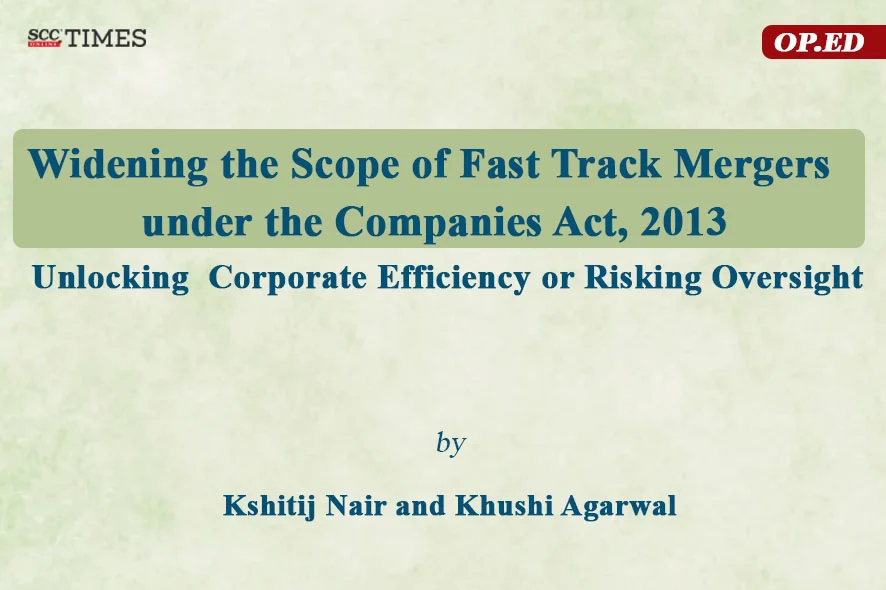Introduction
The Ministry of Corporate Affairs (MCA) recently proposed amendments to the Companies (Compromises, Arrangements and Amalgamations) Rules, 2016 (the Rules) through Draft Amendment Rules, inviting public comments. The proposed amendments aim to widen the scope of entities that have the option to opt for the fast track merger (FTM) process under Section 2331 of the Companies Act, 2013 (the Act)2. This move purports to fasten the process of mergers for entities such as unlisted public companies and certain intra-group entities that were previously excluded from this framework. It aims to boost the Government’s vision of improving ease of doing business in India, while maintaining bureaucratic efficiency.
Section 233 provides a simplified procedure for mergers between specified categories of companies. Specifically, mergers between: (i) two or more small companies, (ii) holding company and its wholly-owned subsidiary, (iii) two or more startup companies, and (iv) one or more startup companies and one or more small companies are given this benefit. These mergers bypass the scrutiny of National Company Law Tribunal (NCLT) and instead require approvals from shareholders, creditors, and the Regional Director. This offers a relatively faster and inexpensive route for amalgamations that are not considered high-risk mergers by the Government in relation to public interest.3 However, due to restrictive eligibility, its use has been limited. Proposed amendments released in April 2025 aim to expand its scope by including unlisted public companies, allowing mergers between a holding company and its unlisted (not wholly-owned) subsidiaries, enabling mergers between subsidiaries under the same parent, and permitting mergers involving foreign holding companies and their Indian wholly-owned subsidiaries. If implemented, these changes would significantly enhance the utility of Section 233 for group restructuring and internal consolidation, particularly benefiting large conglomerates and group companies with complex corporate structures. The proposed amendments also further the goals of the insertion of Rule 25-A(5) into the Rules4 in 2024, which had catered to “reverse flipping” by permitting an inbound cross-border merger of a foreign holding company into its Indian wholly-owned subsidiary through the FTM process, subject to approval by the Reserve Bank of India (RBI). The currently proposed amendments give impetus to this trend by making it easier for companies with complex holding structures oversees to merge with their Indian subsidiaries.
However, this reform is not without its complexities and risks, particularly to minority shareholders and creditors, which must be carefully addressed.
Risks and concerns: Dilution of oversight?
A closer examination of the proposed amendments reveals key structural and procedural shortcomings that could undermine the very objectives of the fast track merger framework. Firstly, the threshold set in the draft Amendment is an overly narrow safeguard and fails to address broader governance and public interest concerns. It permits fast track mergers where borrowings are below Rs 50,00,00,000 and no repayment defaults exist. A company’s financial indebtedness alone cannot be the sole indicator of its integrity or suitability for fast track mergers. Past instances of fraud, compliance breaches, related-party transactions lacking transparency, and allegations of oppression and mismanagement can severely impact minority shareholders and stakeholders, even in debt-light companies. The reliance on an auditor’s certificate, without a robust mechanism for independent scrutiny, risks enabling companies with questionable governance histories to push through mergers with minimal checks. Therefore, additional filters, such as pending regulatory proceedings, preferential, undervalued, fraudulent, and extortionate (PUFE) transactions, or prior violations of statutory obligations, must be incorporated to ensure that only companies with clean operational and governance records are allowed to merge without NCLT oversight. This is critical to prevent abuse and safeguard stakeholder interests.
Secondly, the existing 90% approval requirement for both creditors and shareholders under the FTM route imposes an unusually high compliance burden,5 which paradoxically renders the process more restrictive than a regular merger under the NCLT route. For mergers not conducted through the FTM process, the Act requires only a 75% majority in value of creditors or shareholders present and voting, making the standard more attainable and practical. By contrast, the 90% threshold under the FTM route often proves unworkable, especially in companies with a wide base of creditors.
Thirdly, while unlisted companies may not be listed on stock exchanges, they can still be public companies, thereby involving considerable public interest. It is critical to distinguish between “listed” and “public” companies. Listing affects regulatory oversight, but public companies, even if unlisted, can have wide public shareholding and public-facing operations. Importantly, unlisted public companies are subject to less rigorous scrutiny compared to their listed counterparts, creating regulatory gaps. Including such entities in a fast track process, originally meant for small or less complex private companies with minimal public interest, blurs the line between commercial expediency and protection of stakeholder rights. The judiciary’s interpretation of “public interest” in commercial matters, as seen in Hindustan Lever Employees’ Union v. Hindustan Lever Ltd.6, is dynamic and non-exhaustive. While the Companies Act, 19567, explicitly empowered tribunals to reject mergers prejudicial to public interest, the 2013 Act omits this safeguard, signalling a legislative shift toward endorsing commercial discretion over judicial intervention. Nevertheless, tribunals, as seen in Wiki Kids Ltd. v. Regional Director8 and Gabs Investments (P) Ltd., In re9, have still exercised greater scrutiny over mergers involving public companies. This amendment risks undermining the rationale behind the current FTM framework. The process was originally designed for companies with limited public impact, such as small companies or wholly-owned subsidiaries, where regulatory oversight could be relaxed without compromising stakeholder interests.10 Unlisted companies, despite not being listed on stock exchanges, may still involve broad public shareholding and significant public exposure. Including them in the same category as small private entities ignores the layered nature of public interest.
Finally, the proposed amendment allowing more classes of unlisted companies to use the FTM route raises serious concerns about the fairness of valuation. Under the regular merger process, the NCLT plays a critical role in examining whether share valuations are just and equitable. In Wiki Kids case11, for instance, the NCLT took suo motu cognizance to scrutinise the valuation and found it inflated by the promoter, thereby rejecting the scheme in public interest. However, in FTM, this safeguard is absent. The process is overseen by the Central Government through the Regional Director, who primarily checks for procedural compliance under Section 233 of the Act, without delving into substantive issues like valuation.12 This may still be acceptable for existing categories that are eligible for FTM, which involve wholly-owned subsidiaries and small companies with limited shareholders. However, the inclusion of new categories, particularly unlisted public companies, introduces a greater risk of unfair valuation practices going unchecked, which could potentially harm minority shareholders.
Persisting issue: Timely completion of merger
Amidst these new challenges, a subsisting issue in the FTM framework, which has been present since its introduction, is delay in the completion of the merger. Although the framework was intended to expedite the process, it faces an issue with adherence to fixed timelines. Having notice of this issue, the MCA had amended the Rules to introduce “deemed approval” of the Regional Director, if there is no confirmation or rejection within 60 days.13 Nevertheless, there is a high pending rate of mergers.14 Even with the “deemed approval”, FTM still takes a long duration to complete the process from its initiation till its completion,15 which is a lengthy timeline. To contextualise India’s FTM framework, a comparison with the leading jurisdiction of Delaware in the United States is instructive. Section 253 of the Delaware General Corporation Law16, or the short form merger offers a similar framework for mergers between parent companies and their subsidiaries. A parent company that owns 90% of the shares of the subsidiary company is eligible for such a merger. The process involves a simple resolution passed by the parent company’s Board of Directors, without a mandate for the subsidiary company’s Board of Directors to vote on the same. The merger is completed through a simple filing of a certificate of ownership and merger, which includes the parent company’s Board resolution. There is no shareholder and creditor approval required, unlike India’s FTM process. This reduces the overall time taken for the completion of a short form merger. The protection for creditors is not derived from the merger framework, but instead from fraudulent transfer laws and the contractual rights. Furthermore, the only protection granted to dissenting shareholders in the short form merger framework is to a judicial appraisal of a fair value of their shares as of the date of merger, which the entity is obligated to compensate.
Such a framework may be helpful for wholly-owned or substantially-owned entities, because such mergers are a mere procedural formality, but India’s framework is expanding to various types of mergers. In such an instance, while the Delaware model provides timely completion of a merger, it risks minority shareholder’s rights getting diluted. Thus, the question that is posed is to what extent is such a model desirable and feasible for India. The balance between timelines and protection of stakeholder interests needs to be determined in order to make meaningful changes to the framework.
Conclusion
The vision to ease corporate restructuring for considerably low-risk entities is showcased in the proposed amendment to Section 233 of the Act. However, the inclusion of further categories of entities into the FTM framework must be approached with caution. Expanding the ambit of FTM framework to include unlisted public companies and group structures poses a risk to the dilution of necessary safeguards that were originally inserted to protect public and stakeholder interests. Concerns around high thresholds for approval, insufficient financial and governance checks, and valuation transparency must be addressed to preserve the integrity of the process. The framework must integrate more practical approval thresholds aligned with existing merger norms along with stricter eligibility checks to truly balance procedural ease with regulatory prudence. Without such refinements, the fast track route may inadvertently become a tool for expediency at the cost of accountability, fairness, and stakeholder protection. Furthermore, despite the increase in its ambit, Section 817 companies remain out of its scope, which may benefit from such low-cost mergers. Additionally, demergers do not have a similar fast track mechanism to facilitate crucial corporate restructuring in a timely manner. Therefore, the proposed framework is a step towards easier corporate restructuring, but the cross-section of stakeholder interests and further scope of increasing its ambit remain unanswered.
*Final year law student, Jindal Global Law School, O.P. Jindal Global University. Author can be reached at: kshitijnair2507@gmail.com.
**Final year law student, Jindal Global Law School, O.P. Jindal Global University. Author can be reached at: khushiagarwal252510@gmail.com.
1. Companies Act, 2013, S. 233.
3. Rajat Sethi, Apurv Sharma and Ameesha Tripathi, “Fast Track Mergers in India: Feasibility and Key Legal Challenges”, S&R Associates (snrlaw.in, 4-3-2025).
4. Companies (Compromises, Arrangements and Amalgamations) Rules, 2016, R. 25-A(5).
5. Hardeep Sachdeva, Sudish Sharma and Devyani Jowel, “Fast Track Mergers — A Step Forward”, AZB & Partners (azbpartners.com, 3-8-2023).
8. (2018) 206 Comp Cas 147 : 2017 SCC OnLine NCLAT 535.
9. 2018 SCC OnLine NCLT 25562.
10. J.J. Irani Committee, Report of the Expert Committee on Company Law (2005).
11. (2018) 206 Comp Cas 147 : 2017 SCC OnLine NCLAT 535.
12. Hardeep Sachdeva, Sudish Sharma and Devyani Jowel, “Fast Track Mergers — A Step Forward”, AZB & Partners (azbpartners.com, 3-8-2023).
13. Companies (Compromises, Arrangements and Amalgamations) Amendment Rules, 2023.
14. Himanshu Verma, “Fast-Track Mergers in India: Race Towards Success or Bumpy Ride?”, Centre for Business & Commercial Laws, NLIU Bhopal (cbcl.nliu.ac.in, 31-8-2023).
15. Hardeep Sachdeva, Sudish Sharma and Devyani Jowel, “Fast Track Mergers — A Step Forward”, AZB & Partners (azbpartners.com, 3-8-2023).
16. General Corporation Law (US), 1899, S. 253. (Delaware Code).



